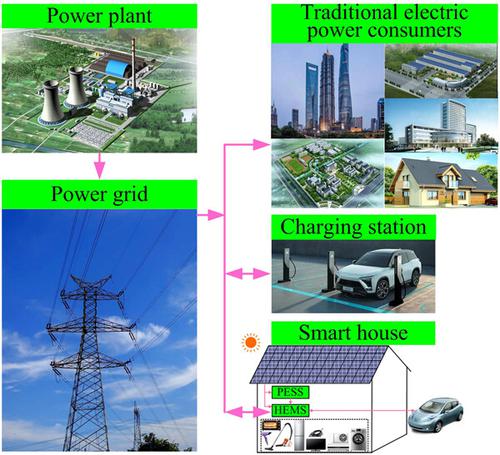当前位置:
X-MOL 学术
›
Energy Sci. Eng.
›
论文详情
Our official English website, www.x-mol.net, welcomes your feedback! (Note: you will need to create a separate account there.)
An improved NSGA‐II for the dynamic economic emission dispatch with the charging/discharging of plug‐in electric vehicles and home‐distributed photovoltaic generation
Energy Science & Engineering ( IF 3.8 ) Pub Date : 2024-03-09 , DOI: 10.1002/ese3.1715 Peifeng Wu 1 , Dexuan Zou 2 , Guoyun Zhang 3 , Hao Liu 1
Energy Science & Engineering ( IF 3.8 ) Pub Date : 2024-03-09 , DOI: 10.1002/ese3.1715 Peifeng Wu 1 , Dexuan Zou 2 , Guoyun Zhang 3 , Hao Liu 1
Affiliation

|
This paper investigates four energy utilization scenarios with or without home‐distributed photovoltaic generation (HDPG) to reduce the generation cost and pollutant emission of the dynamic economic emission dispatch with the charging/discharging of plug‐in electric vehicles (DEED‐PEV). The first scenario considers valley filling for the charging of PEVs. The second scenario combines valley filling and peak shaving for the charging and discharging of PEVs. The third scenario adds peak shaving of HDPG to the first scenario, followed by the peak shaving with the discharging of PEVs. The fourth scenario rearranges the distribution of photovoltaic (PV) power for the third scenario, and the PV power in the afternoon is stored by a photovoltaic energy storage system (PESS) and consumed in the evening. A universal procedure is designed for the valley filling and peak shaving of the four scenarios, which is beneficial for determining the filled and shaved loads with respect to certain time intervals. An NSGA‐II method based on a modified crossover and an elimination of individuals (NSGA‐II‐MCEI) is proposed for the multiobjective optimization of DEED‐PEV. The modified crossover can improve the convergence of NSGA‐II‐MCEI, and the elimination operator can maintain the evenness of the nondominated solutions. According to experimental results, scenario 4 achieves cost savings of 95386.62 $, 85636.87 $, and 6776.85 $, respectively, for Scenarios 1, 2, and 3, and it reaches emission reductions of 27617.64 kg, 17252.71 kg, and 220.98 kg, respectively, for scenarios 1, 2, and 3. Also, scenario 4 outperforms the other three scenarios for three weather conditions such as sunny day, cloudy day, and rainy day.
中文翻译:

改进的 NSGA-II,用于插电式电动汽车充电/放电和家庭分布式光伏发电的动态经济排放调度
本文研究了有或没有家庭分布式光伏发电(HDPG)的四种能源利用场景,以降低插电式电动汽车充电/放电动态经济排放调度(DEED-PEV)的发电成本和污染物排放。第一种情况考虑为 PEV 充电进行填谷。第二种场景结合了PEV充放电的填谷和调峰。第三种情景是在第一种情景的基础上增加HDPG调峰,然后再通过PEV的放电进行调峰。第四种场景对第三种场景的光伏电力分配进行了重新安排,下午的光伏电力通过光伏储能系统(PESS)进行存储,并在晚上消耗掉。针对四种场景的填谷调峰设计了通用程序,有利于确定特定时间间隔内的填谷荷载和削峰荷载。提出了一种基于改进交叉和个体消除的 NSGA-II 方法(NSGA-II-MCEI),用于 DEED-PEV 的多目标优化。改进的交叉可以提高NSGA-II-MCEI的收敛性,消除算子可以保持非支配解的均匀性。根据实验结果,情景4比情景1、2、3分别节省成本95386.62 $、85636.87 $、6776.85 $,减排量分别为27617.64 kg、17252.71 kg、220.98 kg,对于场景 1、2 和 3。此外,对于晴天、阴天和雨天等三种天气条件,场景 4 优于其他三种场景。
更新日期:2024-03-09
中文翻译:

改进的 NSGA-II,用于插电式电动汽车充电/放电和家庭分布式光伏发电的动态经济排放调度
本文研究了有或没有家庭分布式光伏发电(HDPG)的四种能源利用场景,以降低插电式电动汽车充电/放电动态经济排放调度(DEED-PEV)的发电成本和污染物排放。第一种情况考虑为 PEV 充电进行填谷。第二种场景结合了PEV充放电的填谷和调峰。第三种情景是在第一种情景的基础上增加HDPG调峰,然后再通过PEV的放电进行调峰。第四种场景对第三种场景的光伏电力分配进行了重新安排,下午的光伏电力通过光伏储能系统(PESS)进行存储,并在晚上消耗掉。针对四种场景的填谷调峰设计了通用程序,有利于确定特定时间间隔内的填谷荷载和削峰荷载。提出了一种基于改进交叉和个体消除的 NSGA-II 方法(NSGA-II-MCEI),用于 DEED-PEV 的多目标优化。改进的交叉可以提高NSGA-II-MCEI的收敛性,消除算子可以保持非支配解的均匀性。根据实验结果,情景4比情景1、2、3分别节省成本95386.62 $、85636.87 $、6776.85 $,减排量分别为27617.64 kg、17252.71 kg、220.98 kg,对于场景 1、2 和 3。此外,对于晴天、阴天和雨天等三种天气条件,场景 4 优于其他三种场景。



























 京公网安备 11010802027423号
京公网安备 11010802027423号